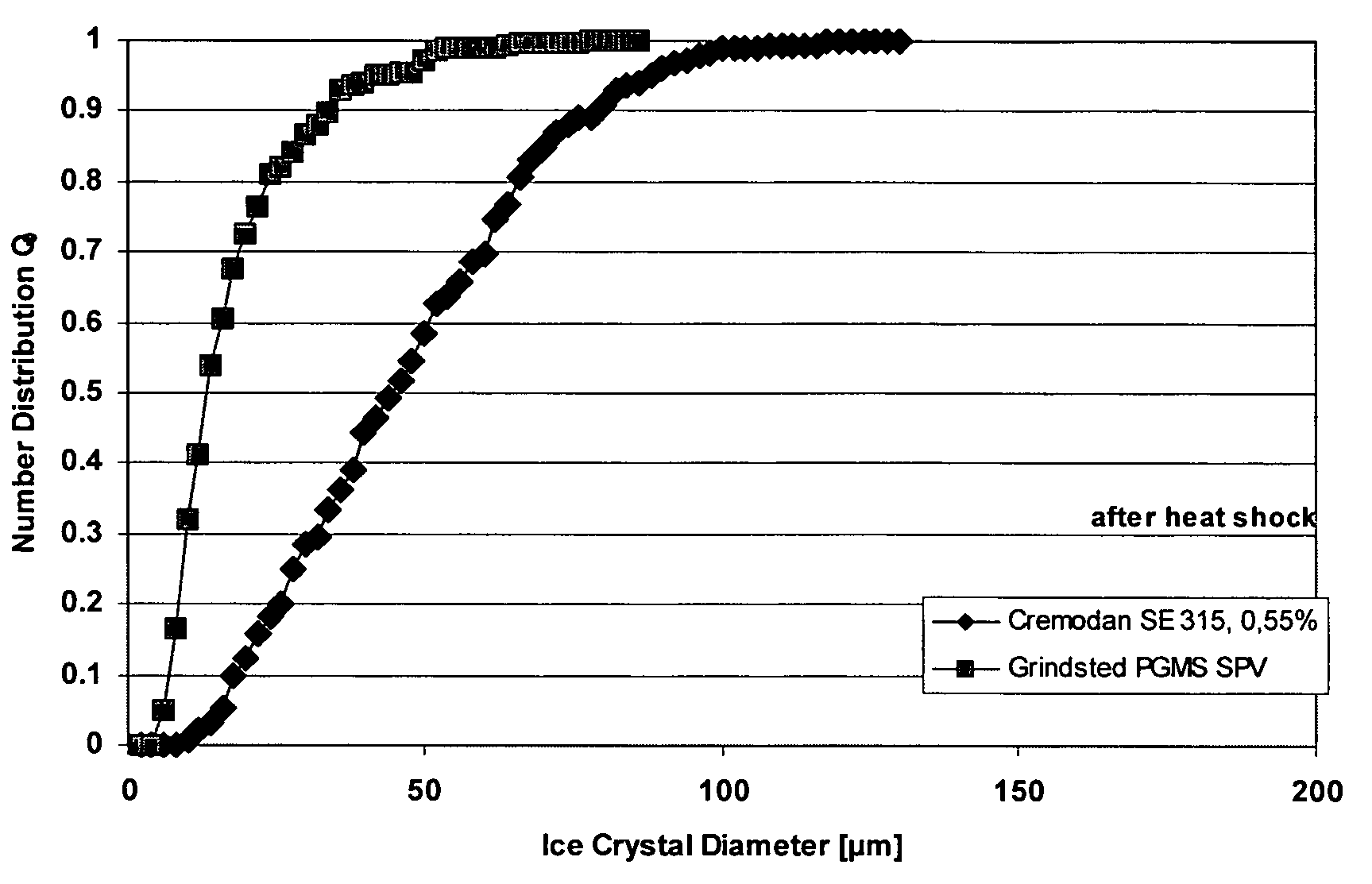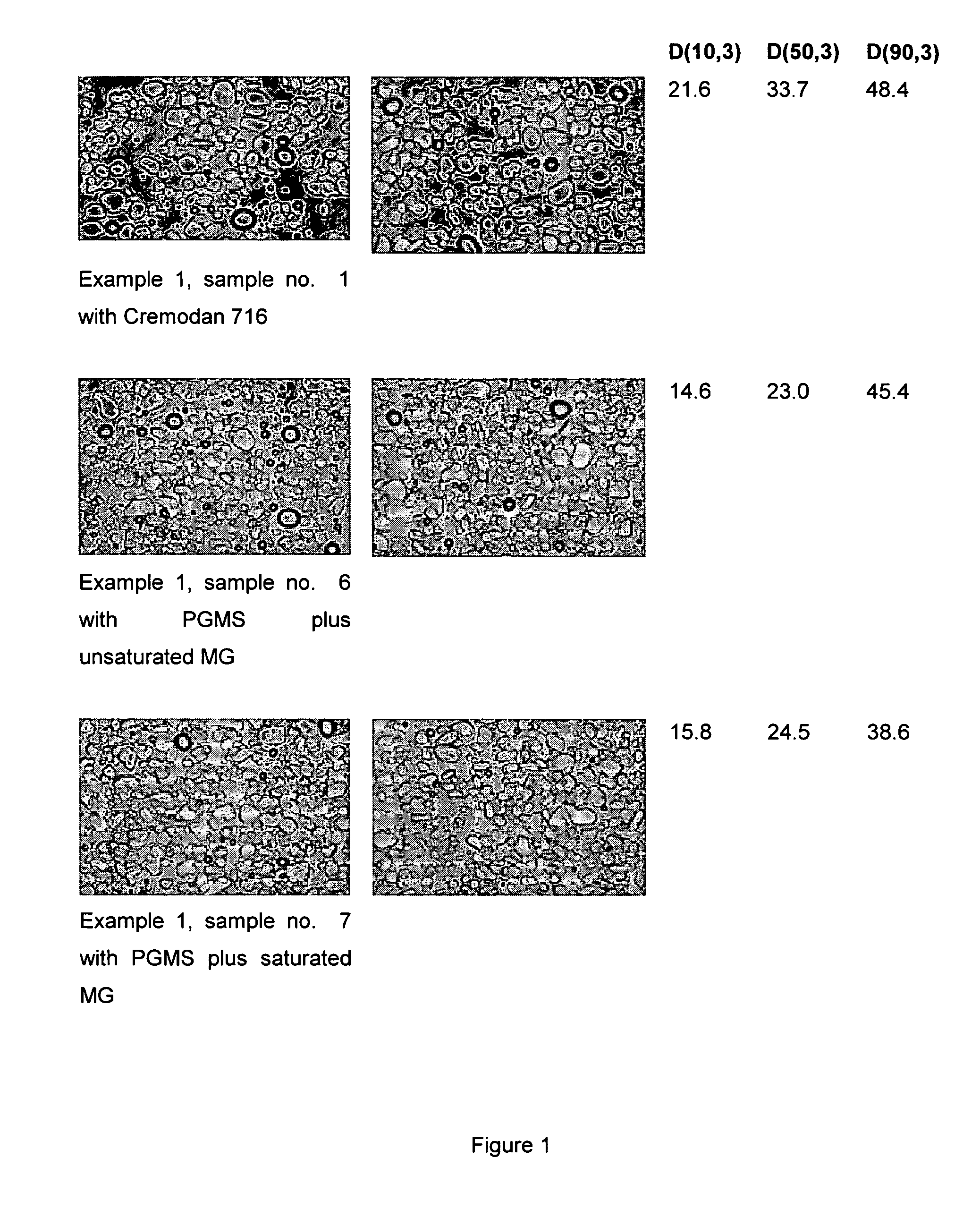Process for production of a frozen food product
a technology of emulsifier and frozen food, which is applied in the field of processing for the production of frozen food products and the use of emulsifier systems, can solve the problems of loss of frozen food quality, ice crystal growth, and loss of quality, so as to prevent further ice crystal growth, inhibit the growth of ice crystals, and strengthen the protection against ice crystal growth
- Summary
- Abstract
- Description
- Claims
- Application Information
AI Technical Summary
Benefits of technology
Problems solved by technology
Method used
Image
Examples
example 1
[0207]Ice cream was prepared using the ingredients described in Table 1 using a conventional freezer as a whipper. The ice-cream had an overrun of 120%. The drawing temperature from the freezer outlet was constant at −5.5° C. After whipping the ice cream in the freezer, the product were filled into containers, conventionally hardened in a hardening tunnel at −25° C. and stored at −25° C.
[0208]
TABLE 1Sample Number12345678Water64.00064.08064.20064.08064.03063.93063.93064.000Polawar 708.0008.0008.0008.0008.0008.0008.0008.000Skimmed Milk Powder11.00011.00011.00011.00011.00011.00011.00011.000Sucrose16.00016.00016.00016.00016.00016.00016.00016.000GRINDSTED ® STS———0.300———0.03030DIMODAN ® UP / B——0.180—0.0500.150—0.050DIMODAN ® HR——————0.150—GRINDSTED ® PGMS—0.300——0.3000.3000.3000.300SPVGuar gum (E412)—0.2000.2000.2000.2000.2000.2000.200Carrageenan (E407)—0.0200.0200.0200.0200.0200.0200.020CREMODAN ® SE 7160.600———————Vanilla Flavouring0.3000.3000.3000.3000.3000.3000.3000.300Colouring (Ann...
example 2
[0221]Ice cream was prepared using the ingredients described in Table 4 using a conventional freezer as a whipper. The ice cream had an overrun of 120%. The drawing temperature from the freezer outlet was constant at −5.5° C. After whipping the ice cream in the freezer, the product were filled into containers, conventionally hardened in a hardening tunnel at −25° C. and stored at −25° C.
[0222]
TABLE 4Sample NumberComposition in percentages1234Water64.16064.01063.86063.810Polawar 708.0008.0008.0008.000Skimmed Milk Powder7.7007.7007.7007.700Demineralised whey powder3.3003.3003.3003.300Sucrose12.00012.00012.00012.000Glucose Syrup Powder, 32 DE4.2304.2304.2304.230GRINDSTED ® PGMS SPV0.1500.3000.4500.500Guar gum0.2000.2000.2000.200Carrageenan0.0200.0200.0200.020Vanilla Flavouring0.1400.1400.1400.140Colouring (Annatto)0.1000.1000.1000.100TOTAL100.000100.000100.000100.000
[0223]In this trial PGMS was used as the single emulsifier in different dosages.
[0224]One set of ice cream samples was an...
example 3
[0227]Ice cream was prepared using the ingredients described in Table 6 using a conventional freezer as a whipper. The ice cream had an overrun of 120%. The drawing temperature from the freezer outlet was adjusted to −3.0° C., −4.0° C., −5.0° C. and −6.0° C. After whipping the ice cream in the freezer, the product were filled into containers, conventionally hardened in a hardening tunnel at −25° C. and stored at −25° C.
[0228]
TABLE 6Sample NumberComposition in percentages1Water64.030Polawar 708.000Skimmed Milk Powder7.700Demineralised whey powder3.300Sucrose12.000Glucose Syrup Powder 32 DE4.210GRINDSTED ® PGMS SPV0.300Guarmel 14000.200Carrageenan 20710.020Vanilla Flavouring NI U356440.140Colouring (Annatto)0.100TOTAL100.000
[0229]One set of ice cream samples was analysed fresh (after 3 days storage at −25° C., followed by one day at −18° C.) for ice crystal size using image analysis and light microscopy at −15° C. Table 7 shows the results of the ice crystal size analysis of the fresh...
PUM
 Login to View More
Login to View More Abstract
Description
Claims
Application Information
 Login to View More
Login to View More - R&D
- Intellectual Property
- Life Sciences
- Materials
- Tech Scout
- Unparalleled Data Quality
- Higher Quality Content
- 60% Fewer Hallucinations
Browse by: Latest US Patents, China's latest patents, Technical Efficacy Thesaurus, Application Domain, Technology Topic, Popular Technical Reports.
© 2025 PatSnap. All rights reserved.Legal|Privacy policy|Modern Slavery Act Transparency Statement|Sitemap|About US| Contact US: help@patsnap.com



